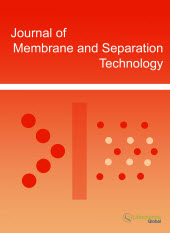jmst
Abstract : Investigation of the Acid Strength Effects on Bipolar Membrane Electrodialysis
|
|
Abstract: The purpose of this paper is to investigate acid strength effects onthe same system for production of two different acids. Production of two different acids from their salts was carried out by electro dialysis (ED) using bipolar membranes (BPM). An virulent acidhydrofluoricacid and an weak acid boric acid were produced, all data were recorded and compared. Result of the study, in electro dialysis of acids and base, acid strength play an important role in terms of the efficiency of the process. Current efficiency was calculated very high at all processes for this electro dialysis (EDBM) system.This results in a growing demand for alternative process solutions such as Electro dialysis with Bipolar Membranes (EDBM). Keywords: Bipolar Membrane, Ion Migration, Current, Acid Strength.Download Full Article |
Abstract : Removal of Metal Ions from Aqueous Solutions by Complexation –Ultrafiltration Hybrid Process: A Bibliographical Overview
|
|
Abstract: Water pollution by metal ions contaminants is a worldwide alarming problem. Clean and safe water is becoming in the same time an increasing scare resource. Thus, to keep this fundamental resource available and suitable for use, water treatment methods are investigated by means of numerous research studies since the purification of water and its re-use and, in a larger scale, the environmental protection will be essential henceforth in any strategy of development. Membrane processes, in general, and ultrafiltration, in particular, develop, without stopping, since the beginning of the sixties to meet the vital need for environmental safety which justifies the policies of durable development adopted today all over the world. Thanks to its growing, ultrafiltration becomes an irreplaceable weapon in the control of pollution. It is classified as a soft and clean technology since it needs low energy consumption and ensures a notable reduction in pollution production during the treatment step. Ultrafiltration is a pressure driven membrane process with the ability to separate molecules in solution on the basis of size. A microporous ultfafiltration membrane retains species with molecular weight higher than its cut off, while small molecules as solvents and microsolutes can pass freely through it. Thus, metal ions aren’t rejected by ultrafiters. However, ultrafiltration can be used to remove metal ions from aqueous solutions by coupling the process with complexation. Indeed, the complexation of metal ions using water soluble polymers as substrates is able to expand artificially the size of the metallic species so as to make possible their rejection by the microporous ultrafilters. The complexation –ultrafiltration hybrid process was first suggested at the end of the sixties by A. S. Michaels. Since then, many studies have shown its effectiveness in the treatment of aqueous solutions containing metal ions. This paper gives an overview of academic studies that illustrate and demonstrate the efficiency and the promising of the hybrid process in the purification of water from metal ions contaminants beforehand sequestered by adequate water –soluble macromolecular substrates. Keywords: Ultrafiltration, complexation, hydrosoluble polymers, metal ions, macromolecular complex.Download Full Article |
Abstract : Remediation of Wastewater Containing Heavy Metals Using Modified Diatomite
|
|
Abstract: Diatomite, wood fly ash and their mixture with TiO2 were tested as adsorption substrates for copper and cadmium cations removal from wastewater. Raw diatomite and wood ash were pretreated and stabilized by washing and were comparatively investigated as adsorption substrates for heavy metals. Further on, a composite mix of pretreated diatomite and wood ash was obtained by mixing with nano-structured TiO2, to increase the surface area of the substrate materials. The novel adsorbent was investigated in terms of crystallinity (XRD), surface properties (AFM, SEM, porosity and BET surface) and surface chemistry (EDX, FTIR). Equilibrium studies demonstrated that the novel material has a high capacity for Cu2+ and Cd2+ removal, showing removal efficiencies above 80% for cadmium and of 99% for copper cations, in optimised adsorption experiments. In this paper the kinetic mechanisms of the cation adsorption are discussed and are correlated with the substrates properties. Keywords: Diatomite, adsorption, heavy metals, wastewater.Download Full Article |
Abstract : Preparation and Performance of Catalytic Hollow Fibre Membranes for Hydrogenation Reduction of Nitrites in Water
|
|
Abstract: Porous Al2O3 hollow fiber membranes have been fabricated via a phase inversion – sintering technique. Pd-loaded carbon nanotubes(CNTs) are formed inside the hollow fibre wall by the catalytic decomposition of methane over Fe particles, followed by impregnation and reduction with hydrogen to form catalytic hollow fibre membranes. Hydrophobic modification of the hollow fibres is conducted by gas permeable polymeric coating. The resultant hollow fibre membranes exhibit highly catalytic activity to the hydrogenation reduction of nitrites in aqueous solution. Hollow fibre membrane reactors are assembled for nitrite hydrogenation by pumping nitrite solution into the tube side and introducing hydrogen countercurrently to the shell side of the reactor. The nitrite removal in the hollow fibre membrane reactors increases with the operation temperature and the hydrogen feed concentration at lower hydrogen partial pressures, but less influenced by the hydrogen feed concentration when it is higher than 50%. A higher nitrite concentration favors the nitrite hydrogenation reaction but lowers the nitrite removal efficiency. Keywords: Hollow fibre,catalytic membrane reactor,nitrite removal,hydrogenation reduction.Download Full Article |
Abstract : Heparin-Mimicking Polymer Modified Polyethersulfone Membranes - A Mini Review
|
|
Abstract: Recent studies on the modification of polyethersulfone (PES) membranes using heparin-mimicking polymers are reviewed. The general conception of heparin-mimicking polymersis defined as the syntheticpolymers (including the biopolymer derivates and synthetic sulfated artificial polymers) with similar biologically functionalities as heparin, such as the anticoagulant, growth factor binding, and also disease mediation. In the review, heparin-mimicking polymers is briefly reviewed; then heparin-mimicking polymer modified PES membranes, including blended, coated, and grafted membranes are discussed respectively. Keywords: Heparin-mimicking, polyethersulfone, blood compatibility, blending, coating.Download Full Article |


